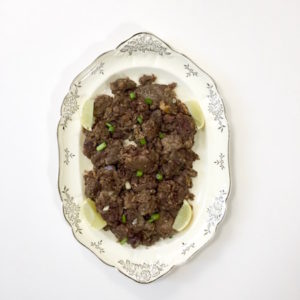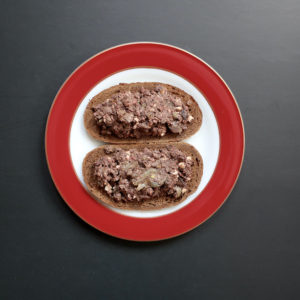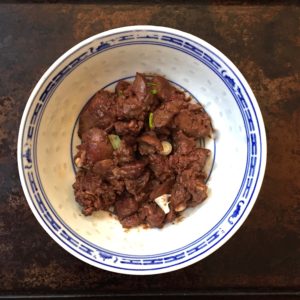Chicken Livers with Rice
I was well into adulthood before learning chicken livers are considered offal. When I think of offal, I think of lungs and testicles, ears and eyeballs, tongues and tripe.
Clearly I am in the minority.

Determined to defend the delights of chicken livers, or at least get to eat some myself, I decided to demonstrate chopped liver for the blog. To this end, I penned several snarky paragraphs about the dearth of decent chopped liver in California. I added some misty sentences about the chopped liver of my youth, eaten in the delis of Detroit, Michigan. There were tangents about my grandparents and the Jewish butchers of Oak Park’s Greenfield Road. All of these people are now deceased.

Many of the photographs will be unrelated to chicken liver this time around. Any complaints may be directed to dianesleach@gmail.com. Meanwhile, pears atop an old fabric napkin.
You will be relieved to hear both my plans and my screed had to be scrapped. This because nary a tub of chicken could be found. Duck fat and lard line the market shelves, along with coconut in oil and solid form, palm oil (politically incorrect, but widely available), and, of course, all manner of “healthy” fats, alarming concoctions formulated in labs and sold to a frantic, fearful public.
Annoyed but undeterred, I consulted Elizabeth David’s French Provincial Cooking. In short order I found Chicken Livers with Rice,” which translates pretty directly into Foies de Volaille Au Riz.

A little throat clearing before we enter the kitchen.
Chicken livers are extremely perishable. Either cook them the day you purchase them, or freeze them immediately.

Vintage Pyrex, new to me.
As the liver’s job is the cleanse the body of toxins, this is the rare instance that I suggest you purchase organic. Even now, in this insanely inflated moment, chicken livers remain extremely inexpensive.

I have never had a coffee drink involving pumpkin. Hopefully I never will.
If your livers have any green bile sacs, trim them carefully, as they extremely bitter to eat, and not in a pleasant way.
Overcooking is the enemy of decent chicken livers: treat them as you would fish, aiming for undercooked rather than well done. You want chicken livers that are barely pink inside.

The only time in my life I’ve poured out liqueur. It was that awful. But the bottle is beautiful. At least I got something out of it.
Only a fool would mess with an Elizabeth David recipe, and I am not that fool. The only part of Ms. David’s recipe I altered is the rice cooking method, as hers required two parts, the first asking for a large pot of boiling water, as for pasta: the rice was placed in this, drained, put back in the pot, covered with broth, and finished in the oven.

One of the few photos from the chicken liver blog shoot that’s good enough to be here.
Doubtless rice is delicious this way, but Ms. David lived and cooked in rainy London, where water was and is plentiful. I live in drought-stricken California, where water is alarmingly scarce. All to say, I prepare rice by the absorption method. This is not a criticism of Elizabeth David. Rather, it is an adjustment to a terrifying reality. I can only hope she would understand.
If you have a rice cooker, by all means use it. I cook my rice in a little black pot from The Wok Shop. Prior to acquiring this pot I was a hopelessly terrible rice cook. Now my rice is always perfect, which has everything to do with the pot and nothing to do with me.

Chicken Livers with Rice
With a very few changes from Elizabeth David’s French Provincial Cooking
Serves: 2 for dinner or 4 as an appetizer, please see notes, below
8 ounces/250 grams Basmati rice
16 ounces/454 ml low salt chicken broth, preferably homemade.
4-5 ounces/100-125 grams chicken livers, organic if possible
about 1/2 cup/4 ounces/100 grams all-purpose flour, with salt, pepper, and dash paprika, if wished
2-3 tablespoons sweet butter, for the pan
2 ounces/60 grams ham, chopped (optional, see notes)
2-3 tablespoons white wine, Vermouth, or Madeira
1 garlic clove, peeled and crushed (optional but nice)
Additional broth, for the pan, or additional liquor, if broth is unavailable. Barring these, water is fine.
Cook your rice however you make rice, using chicken broth instead of water. I use the absorption method with a pot, but if you prefer a rice cooker, please use it.
Unwrap the livers and put them in a colander. Rinse them gently under cold water. If you see any green bile sacs, carefully trim or cut them off with a sharp knife or scissors. They’re very bitter.
Pat the livers dry with paper towels or a clean dishtowel. You can leave the livers whole, or trim them into pieces for this recipe. To trim them, you can be barbaric, like me, and cut them into pieces with scissors right in the colander, or you can be civilized and place them on a cutting board, and cut them with a knife. I trim them into three pieces for this recipe.
Once the livers are trimmed, take out two wide, shallow bowls: one to flour the livers, and one to hold them once they’re floured. I use pasta bowls for this task.
Shake about 4 ounces/100 grams all-purpose flour into one of the wide bowls. Add salt, pepper, and a dash of paprika. Flour each liver lightly–don’t pack flour on. You want the merest dusting. Move each liver to the waiting bowl.
Once the livers are all floured, place a large sauté pan on the stove. Add the butter and garlic clove, and turn the heat to medium. Once the butter has melted, add the livers and turn the heat down.
Add the liquor and the ham, if using, and stir a bit.
Cook the livers about three minutes, until you see the blood rising. It sounds disgusting, but it’s a sure sign it’s time to flip them over.
If the pan starts looking dry, you can add a bit more broth, if you have some. If not, add the liquor you are using to cook, or a few tablespoons of water.
Turn the livers, and cook another 3-4 minutes. They’re done when you can slide your spatula through them easily, and the liver’s interior is pink. If you cannot cut easily, and the interior appears bloody and raw, cook them little longer. Total cooking time should be 10-12 minutes, but no longer.
I eat the garlic clove, but if you prefer not to, remove it, or serve it to the family garlic fiend.
This dish is pretty with the rice arranged on a platter, the livers atop it, and some parsley atop all. If you cannot be bothered, this dish is best in shallow bowls, as for pasta. It is delicious with a green salad, and works nicely with any cooked green vegetable. I know this sounds really weird, but the whole thing-livers, rice, and all– is fantastic eaten in a pita bread with crisp iceberg lettuce and mild onion. Really. Try it!
The chicken livers will keep, refrigerated, up to four days. Do not keep the rice more than two days.
Chicken livers may be frozen, well-wrapped, up to three months. Defrost in the refrigerator. Do not freeze the cooked rice.
Notes
David says this is a first course for 4; if you plan serving this as a first course, I would make less rice.
Regarding the ham: David doesn’t give specifics about type. I had some sliced French ham in the house and used that; I can’t really think of any ham that would clash with chicken livers. But if you don’t eat pork products, don’t use it.
If you have no chicken broth for the rice, water is fine.





